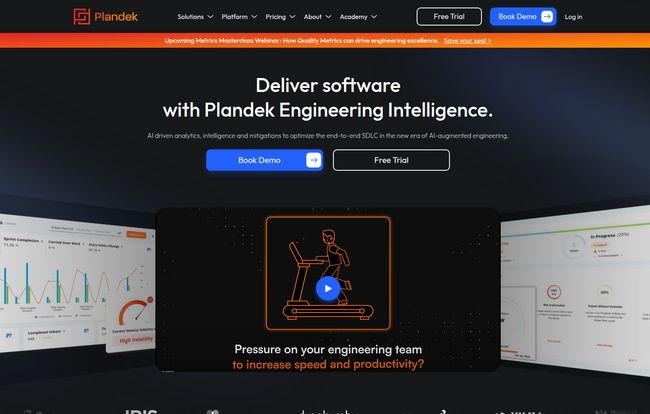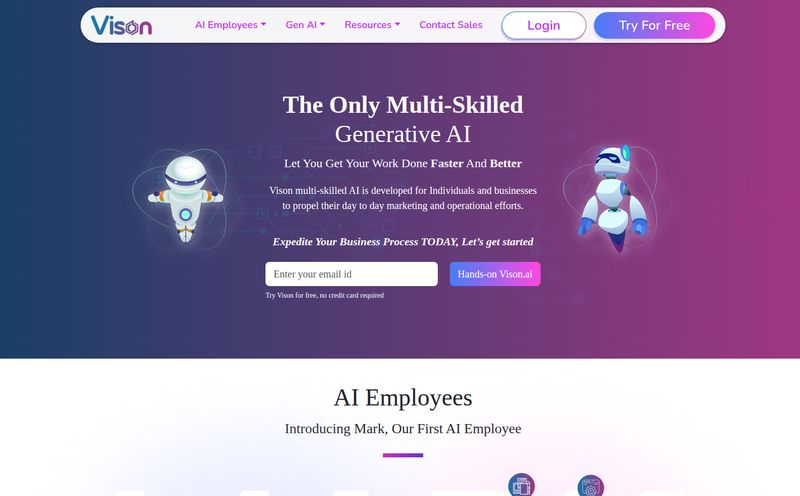If you've ever managed a software team, you know the special kind of chaos that is trying to figure out if you're actually being productive. I remember one gig where our "sprint planning" felt more like a séance. We’d all stare into the depths of a Jira backlog, trying to divine the future, armed with nothing but gut feelings and maybe a half-stale donut. Are we getting faster? Is this epic a death march? Who knows! The data was somewhere, buried across GitHub, Jira, and three different CI/CD tools.
The whole industry has been buzzing about "Engineering Intelligence" and "DORA metrics" for a few years now, and for good reason. We're all desperate to move beyond vanity metrics. But getting there? That’s the hard part. It often means building a fragile, in-house dashboard that someone's cousin's intern built two years ago, and which breaks if you look at it wrong.
This is the problem that platforms like Plandek claim to solve. They promise a "single pane of glass" for smarter software delivery. Big words. But as someone who has been burned by over-hyped tools before, I decided to take a proper look. Is it just another pretty dashboard, or does it actually help you ship better software?
So, What Exactly Is Plandek? (And Why Should You Care?)
Think of Plandek as a super-smart data detective for your engineering organization. It doesn't ask your team to change how they work or adopt yet another tool. Instead, it plugs directly into the toolsets you already use—you know, the Jiras, the GitHubs, the Bitbuckets, the Azures of the world. It then mines all that raw data, the commits, the pull requests, the tickets, the deployments and turns it into something you can actually understand.

Visit Plandek
The key here isn't just that it shows you graphs. Anyone can make a graph. The point is that it surfaces actionable insights. It's designed to connect the dots between team activity and delivery outcomes. It’s the difference between seeing a chart that says "Cycle Time is up" and understanding that it’s because PR pickup time has spiked on a specific team, maybe because a key senior dev is on vacation. That’s the stuff that actually lets you fix things.
The Core Features That Actually Move the Needle
A feature list is just a list. I'm more interested in what problems those features solve. After digging around, a few things stood out to me as genuinely useful.
A True Single Pane of Glass
I can’t be the only one with a browser bookmark folder named "Metrics" that contains links to six different services. The biggest promise of Plandek is consolidating all that noise. It pulls in data and presents it in one place, framed around genuinely useful metric frameworks like DORA (Deployment Frequency, Lead Time for Changes, etc.) and Flow Metrics (Flow Velocity, Flow Efficiency). This means you can have one conversation, using one source of truth, from the C-suite down to the daily stand-up. That alone is kind of a big deal.
Dashboards That Don’t Suck
Most out-of-the-box dashboards are either too generic to be useful or so rigid you can't adapt them to your weird, wonderful, and slightly chaotic internal processes. Plandek seems to get this. Their dashboards are customizable, allowing you to create different views for different audiences. An engineering leader might want a high-level overview of delivery momentum across the entire department, while a team lead needs to get into the weeds of a specific sprint's delivery bottlenecks. The platform allows you to drill down, to find the why behind the what, which is where real improvement begins.
It Plays Nice with Your Existing Stack
The last thing any dev team wants is a mandate to change their entire workflow to accommodate a new reporting tool. Plandek’s approach is to integrate, not dictate. By connecting to the tools your teams are already comfortable with, it reduces friction and adoption headaches. This is a huge, often overlooked, benefit. It becomes a layer of intelligence on top of your process, not a roadblock within it.
The Good, The Bad, and The "It Depends"
No tool is perfect, right? Let's get into the real talk. I've always felt the most helpful reviews are the ones that don't just sing praises. So here's my take on the pros and the potential snags.
On the plus side, the value of having a single, trusted source for delivery metrics is immense. It moves conversations away from "I feel like we're slow" to "Our data shows a bottleneck in QA, let's discuss why." That's a huge cultural win. It provides these actionable insights at every level, and the fact that it integrates with a wide array of tools means it's pretty flexible.
However, there are a few things to keep in mind. The tool isn't magic; it requires integration with your existing DevOps toolchain. That’s not a flaw, just a reality—it needs data to work. And like any powerful analytics platform, there's probably a bit of a learning curve to get the most out of its deep customisation features. It's not something you'll master in an afternoon, and your team might need some training to really leverage it.
Let's Talk Money: Plandek Pricing
Ah, the pricing page. The moment of truth for any tool. Plandek is pretty transparent here, which I appreciate. Their model starts from $25 per contributor, per month. Now, that asterisk is doing a lot of work, as they always do. The final price will likely depend on things like how long your contract is and how many licenses you're buying. Standard SaaS stuff.
Is it expensive? Well, that depends on what you compare it to. If you compare it to the salary of an engineer you hire just to build and maintain internal dashboards, it looks pretty cheap. If you compare it to the cost of a six-month project delay because you didn't spot a critical bottleneck... well, the ROI starts to look pretty compelling. It’s an investment, not just a cost.
"We want to be data-driven... we have made Plandek available for every team. It consistently provides us with highly valuable insights and helps us to find continuous improvement opportunities."
- Hadi Sefid, Head of Engineering, PEI
I also noticed they offer a "free managed POC" (Proof of Concept). This is a smart move. It lets you try before you buy, using your own data to see if it actually provides the insights you need. For any serious evaluation, that’s a must.
Who Is Plandek Actually For?
So, who should be booking a demo? In my opinion, Plandek hits a sweet spot for a few types of organizations.
It seems ideal for growing engineering orgs that are starting to feel the communication and alignment pains that come with scale. If you have multiple teams and you're struggling to get a consistent view of delivery health, this could be for you. It's also a great fit for data-driven leaders who are tired of wrestling with spreadsheets and just want the answers. Some might argue that small, agile teams that all sit in teh same room don't need this level of analytics, and they might be right. But once you scale past that point, the fog of war sets in fast.
Final Thoughts
Look, the quest for perfect visibility in software delivery is a long one. Plandek isn't a silver bullet—nothing is. It won't magically fix your culture or solve all your process problems. But what it does, and what it seems to do well, is shine a very bright light on where those problems are.
It turns the abstract idea of being "data-driven" into a practical reality by connecting to the tools you already use and surfacing insights that are genuinely useful. For the right team, one that's ready to look at its own processes with an honest eye, I believe it could be a game-changer. It’s a powerful tool for turning data chaos into delivery clarity.
Frequently Asked Questions About Plandek
Will Plandek work with my unique, slightly chaotic workflow?
Most likely, yes. The platform is designed to be flexible. Since it integrates with a wide range of standard DevOps tools and allows for customizable metrics and dashboards, it can usually be adapted to fit even complex or non-standard workflows. The key is that the data exists somewhere for Plandek to mine.
I'm new to DORA metrics. Is this tool too advanced for me?
Not at all. In fact, it could be a great way to start. Plandek offers out-of-the-box dashboards for DORA and Flow Metrics, which can help you and your team get up to speed quickly. It provides the definitions and the data, so you can focus on understanding the insights rather than figuring out how to calculate them.
How much support can I expect during setup?
Plandek seems to emphasize a supported setup. They mention having a dedicated Customer Success Account Manager and a support team. They also offer a managed Proof of Concept (POC), which suggests they're very hands-on in helping new clients get started and see value quickly.
Is the $25 per contributor price fixed?
The pricing is listed as starting "From $25". This typically means the final price can vary based on factors like the length of your contract, the number of licenses you purchase, and any additional services you might need. It's best to contact them for a specific quote based on your team's size and needs.
Does Plandek replace tools like Jira or GitHub?
No, and that's one of its strengths. Plandek is an intelligence and analytics platform that sits on top of your existing tools. It integrates with them to pull data, but it doesn't replace them. Your teams continue to work in Jira, commit to GitHub, and so on, just as they always have.



